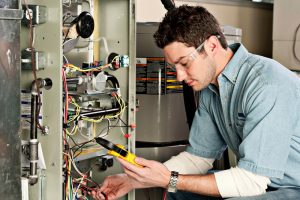 Furnaces are what’s known as a forced-air heating system. While they’re not that complicated conceptually, their internal parts certainly can be. Today, we’ll introduce you to just a few of the components that help you get warm air from your furnace.
Furnaces are what’s known as a forced-air heating system. While they’re not that complicated conceptually, their internal parts certainly can be. Today, we’ll introduce you to just a few of the components that help you get warm air from your furnace.
Heat Exchanger
The heat exchanger is the star of your furnace. It’s truly where all the heating magic comes from.
Although the actual operation of a heat exchanger is much more complex, one simple way to describe it is by comparing it to a hot cup of coffee. If you blow on your coffee, you’ll feel hot air rising from it. That’s sort of how a heat exchanger works.
The heat exchanger creates warm air, and then a series of fans blow that hot air through to the ducts. It will eventually exit the air vents that are installed on the walls of your home’s rooms.
Heat exchangers will perform diligently for several years, but may eventually develop some cracks. When that time comes, you’ll need to have the furnace repaired or replaced immediately to avoid the risk of deadly carbon monoxide leaks.
Igniters and Pilot Lights
Depending on the age of your furnace, it may have either an igniter or a pilot light. Their purpose is to light the gas burners.
If you’ve ever looked inside your toaster or toaster oven, then you have an idea of how a hot surface igniter works. When the igniter has electricity running through it, it will heat up and burn red. This is just enough heat to light the gas burners.
Older systems may use a pilot light. These are made up of a tube that releases a tiny bit of gas, which is then ignited by a flame. Pilot lights are simple but complex enough to close off the gas in the event there’s an issue.
It’s common for these devices to degrade long before the furnace is ready for replacement, so be sure to call up an HVAC service in Rocklin, CA if they are failing to light.
Limit Switch
When you first turn on your heater for the night, it’s going to take some time for the air to actually get warm enough to match the temperature on your thermostat. Until that time comes, the limit switch will hold the door shut. Once the heat is warm enough to be useful to your home, the limit switch tells the air handler to start running and send warm air through your home.
The limit switch also is there to keep you safe. If your furnace is in danger of overheating, the limit switch will shut off the gas supply. A reliable way to detect problems with your furnace is by observing if the limit switch is shutting your furnace off too early.
Air Filter
Last, but certainly not least, is the air filter. The air filter keeps dust and debris out of the sensitive components of the furnace. But if the filter becomes clogged and isn’t replaced, it can block airflow and start causing problems.
In the worst case, it might lead to carbon monoxide leaks. In a better-but-still-not-good case, it will simply cause the limit switch to turn the furnace off.
